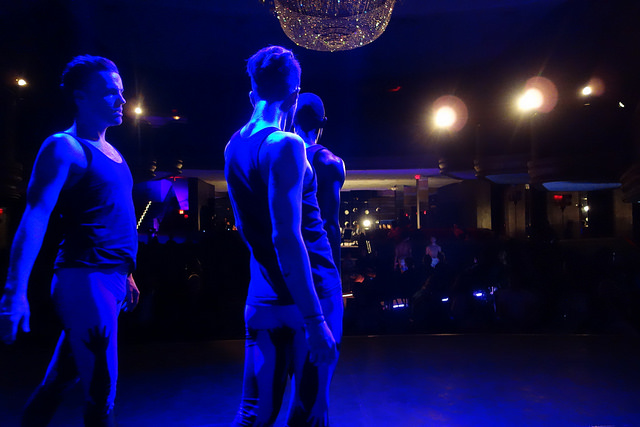
Ryan McNamara, MEEM 4 MIAMI: A Story Ballet About the Internet. Art Basel Miami
With this job, you don’t always have a chance to write up all the exhibitions you saw and loved, so for me, the 2014 year-end review is a Godsend. It gives me a chance to give a shout out to everything I saw and loved. And this year, there was an awful lot of it. May 2015 be this bountiful and more.

Greer Lankton, Participant, Photo: Paddy Johnson
Participant INC
253 East Houston Street, New York, NY
Lower East Side
November 2nd – December 21st
Greer Lankton, Love Me
An awe-inspiring retrospective consisting of hundreds of the late artist Greer Lankton’s dolls, photographs, and drawings, most of which are autobiographical in some way. For this show, that means dolls in the likeness of Lankton depicting her sex-change operation, her anorexia, and her anxieties; dolls in the likeness of friends, and sculptures, photos and drawings usually on the subject of sex.
An awe-inspiring retrospective consists of hundreds of the late artist Greer Lankton’s dolls, photographs, and drawings, most of which are autobiographical in some way. For this show, that means dolls in the likeness of Lankton, depicting her sex change operation, her anorexia, and her anxieties; dolls in the likeness of friends; and sculptures, photos and drawings, usually on the subject of sex.
The show is nothing short of jaw-dropping. On a basic level, it’s incredible to see the volume of Lankton’s production given her short life. She died in 1996 at the age of 38 due to a drug overdose, and yet Participant’s packed exhibition space practically explodes at the seams. Vitrines line the center of the gallery, and photographs and drawings cover the walls, which have been painted black. The exhibition looks less like a diligent gallery retrospective than it does a time capsule of New York in the 80’s; Lankton was acclaimed then with shows at The Whitney Biennial and Venice, but in the aughts her work had largely fallen off of the exhibition circuit.
This show changes that. And what’s crazy is how much of the work in the exhibition truly feels impactful. That’s not always a good thing. There are only so many mutilated dolls a viewer can look at before you start to worry that the artist’s inner life was full of pain and anxiety. With inclusions like the burlap doll with a gaping hole for a vagina, and legs splayed apart with rope, the violence depicted pushes the work into dark territory, and casts a shadow on other lighter works. In the context of this show, a series of belly button photos looks like patterned wounds.
That’s powerful misery, but there’s playfulness here too. In one shot we see Lankton smiling in a bathtub, surrounded by a small collection of her weird dolls. It’s not quite a family portrait, but she looks content and at home.

Nicole Eisenman, “Were Artist”, 2007 Photo: Contemporary Art Daily
ICA
118 S. 36th Street, Philadelphia, PA
September 19th-December 28
Dear Nemisis, Nicole Eisenman 1993-2013
It’s rare when I see a show filled with paintings I not only love, but wish I could own. Dear Nemesis is a mid-career survey of Nicole Eisenman’s work, and it includes over 120 paintings, drawings, prints, and sculptures. That sounds like a lot, but it’s more restrained than one would think. I’d wager about half the works in the show are hung on a single salon-style wall, whereas the rest of the exhibition is made up of large paintings that are given plenty of room to breathe.
And so many are so good. A few favorites: “Captain Awesome,” a 2004 painting of a shirtless bro getting ready to swing a corn cob like a baseball bat. Hilarious. “Mining,” a 2005 painting in which nude peons mine paint from mountains in the Arctic. It’s like Santa’s workshop for artists. And finally, “Were-Artist” (2007), a portrait of a tortured artist whose werewolf hands appear to be hindering his ability to paint.
It’s hard not to fawn over the sheer inventiveness of these paintings, but now that we’re three paragraphs into the fawn, I guess there’s no use resisting. The short of it: an incredible show by an incredible artist.
This show was organized for the Contemporary Art Museum, St. Louis, by Kelly Shindler
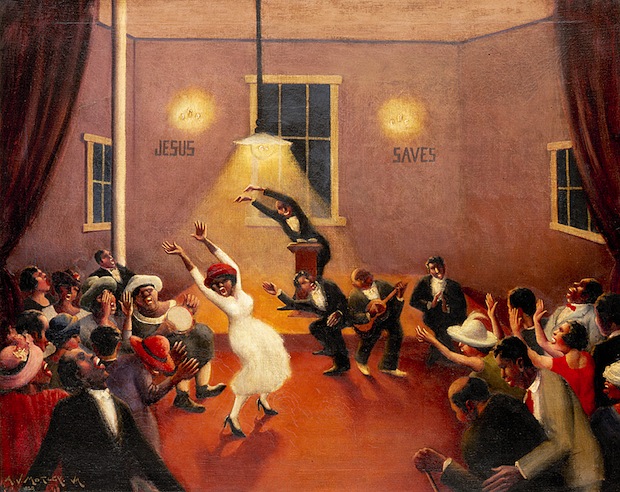
Archibald J. Motley Jr., Tongues (Holy Rollers), 1929. Oil on canvas, 29.25 x 36.125 inches (74.3 x 91.8 cm). Collection of Mara Motley, MD, and Valerie Gerrard Browne. Image courtesy of the Chicago History Museum, Chicago, Illinois. © Valerie Gerrard Browne.
The Nasher Museum of Art
Duke University
2001 Campus Drive Durham, NC
January 30-May 11
Archibald Motley, Jazz Age Modernist
Archibald Motley will debut at The Whitney’s grand reopening this spring, but having visited the show’s original iteration at the Nasher, we got a look in advance of most New Yorkers. It’s an amazing exhibition. His paintings are made from the perspective of a black Chicagoan making art in the mid-20th century, a perspective we don’t see enough of it.
The show is any nerdy curator’s wet dream; the paintings are mostly scattered across the country in small museums, so it’s an essential collection of work. A few words from Whitney Kimball, earlier this year:
“Archibald Motley: Jazz Age Modernist” will soon reintroduce the world to a pretty engrossing oddball. Motley, once well-exhibited with the Harlem Renaissance, is generally known for his paintings of mid-20th century Chicago’s African American social scenes. But up close, theatrical streets and portraits are filled with fly-by-night stylistic changes, racy caricatures, loving tributes to women, fuzzy areas, abrupt compositions, psychedelic lighting, and out-of-this-world color choices. They’re fascinating.

Joy Feasley and Paul Swenbeck: A Hatchet to Kill Old Ugly, The Fabric Workshop. Photo: Paddy Johnson
The Fabric Workshop and Museum
1222 Arch Street, Philadelphia, PA
October 2nd – January 4th
Joy Feasley and Paul Swenbeck: A Hatchet to Kill Old Ugly
An exhibition inspired by Shakers, a female-led religious sect which believes in Christ’s second coming. The space is designed as restrained colonialist interior with additions of similarly restrained disco era elements. In the front room, there’s a woven rug, a chair lifted by a beer bottle on each leg, and fireplace with two wardrobes and a mirror. There’s a subtle repressiveness to the room, perhaps having to do with the utter lack of sexual charge. Shakers are known for their celibacy.
What looks like a green magician’s cape hanging on a peg near the fireplace gives viewers a sense of the artists’ interests; the seen, the unseen, and the imagined. And sure enough, a close look reveals the secrets of this space: you can crawl through the fireplace to a secret room in the back. It’s dark with colored lights rotating above. Light tinkling sounds fill the space, and tiny strobes blink quietly near your feet.
You get the same sense of specialness that crawling inside your best friend’s secret fort might have given you when you were ten, which is pretty great, though my sense is that the artists hope the viewer’s experience will extend beyond that. For the first two weeks in December Martha McDonald sung Shaker songs in the main space, as part of a performance designed to respond to the history the room evoked. I wasn’t lucky enough to see those, but hopefully the video documentation will be made available shortly.
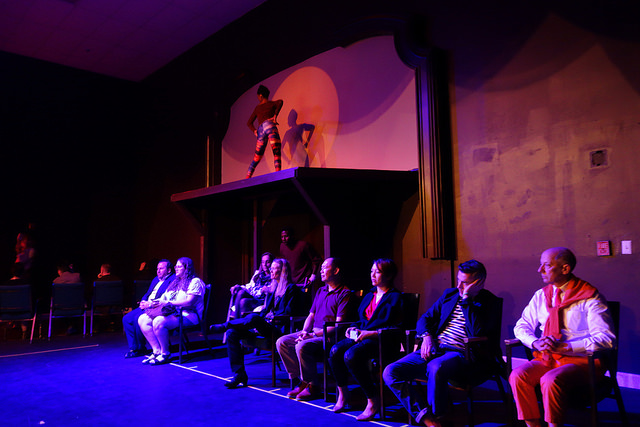
MEEM 4 MIAMI: A Story Ballet About the Internet. Art Basel Miami
Performa
Miami Grand Theater at Castle Beach Resort,
5445 Collins Ave, Miami Beach, Florida
December 3rd & 4th
Ryan McNamara, MEEM 4 MIAMI: A Story Ballet About the Internet
I wrote about McNamara for my top ten digital works on artnet. I think it belongs on this list too, so here’s what I said:
Though barely a lick of it was digital, the best performance of the year was Ryan McNamara’s “MEEM 4 Miami: A Story Ballet About the Internet.” McNamara’s hour-long ballet is an immersive performance defined by ever changing musical scores, a rainbow of light gels and fluorescent tubes, and dancers in wildly printed leotards. As these performers quickly colonized various areas within the Castle Beach Resort theater stagehands were busy carting viewers (via specialized chair lifts) to the different mini-performances around the theater. No two viewers had quite the same experience.
That, at least is the illusion. No matter where you are in the theater, a cohesive narrative emerges. After all, we all see the three lone dancers in spandex who begin the piece by walking in circles while slowed down electronic music and voices play overhead. It feels like an exploration. Closer to the end, we see a final monolith raised (a bench physically lifted) as if to symbolize a coming of age, and a musical grand finale scored to a cacophony of spoken names. Social media has arrived. As in life, many but not all, of the viewers are exposed to the icky sweaty dancer played by McNamara himself whose bumpy spandex attire and willingness to actually touch audience members casts him as a computer virus. Finally, the performers drop to the ground and the lights dim.
At the end of the performance, I was bewildered and disoriented, and only then thought to look for my friends. We’d been separated from the get-go, but the whole time I was wheeled around the theater, I hadn’t once felt alone.
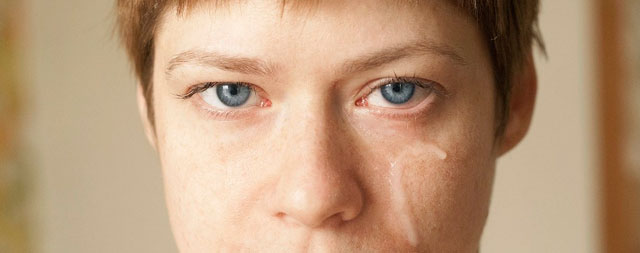
Rebecca Patek, ineter(a)nal f/ear
Abrons Art Center
466 Grand Street (at Pitt Street), New York, NY
January 14th, 15th, 16th
Rebecca Patek, ineter(a)nal f/ear
The best performance of the year, by far. ineter(a)nal f/ear takes a blisteringly satirical look through the various lenses that art can use to frame pain. The piece opens with a satirical confessional video (subtitled in French) of Patek, traipsing blithely under Brooklyn bridges and on rooftop gardens, until one evening a man in a hoodie follows her into her home and rapes her on the bathroom floor. The piece proceeds from here.
From a comment I made about the piece in response to Whitney Kimball’s review:
For me, the whole performance hinged on the phrase “Everything happens for a reason.” It’s one of the first things you hear her say while explaining that’s she’s been raped and she’s forming a support group. It’s the most cliche of chiche idioms, and it seems to apply not just to her experience (as parody), but her practice as well. After we’ve watched her get fucked in a consensual reenactment of rape, against a backdrop of film footage of consensual sex, she asks her dance partner, “What was that about?”. Half the time we don’t know why we do the things we do.
Really, the pleasure of watching a piece like this (if that’s really what it is), is the careful calibration of pitch. You know she’s parodying the struggling artist identity immediately not just her awkward delivery but the ridiculous clips of her, as a struggling Brooklyn artist practicing the most artsy lunges, kicks and arm swinging. She’s a perfect stereotype of a Brooklyn artist, in a place that only occasionally looks like Brooklyn.
That, contrasted with the kind of body flailing that takes place as her dance partner describes his own rape is pretty incredible. Suddenly, you’ve stopped thinking about cliche and you’re just watching a body does in a violent situation like that. It’s bits like these that remind me of an abstract painter’s decision to paint a hand or an object realistically. It’s a flourish meant to remind you their skill is actually very developed.
ineter(a)nal f/ear was made for Festival TBD: Emergency Glitter, a program created by tbspMGMT in partnership with Abrons Arts Center. We saw it at The Abrons Arts Center’s “American Realness” Festival.
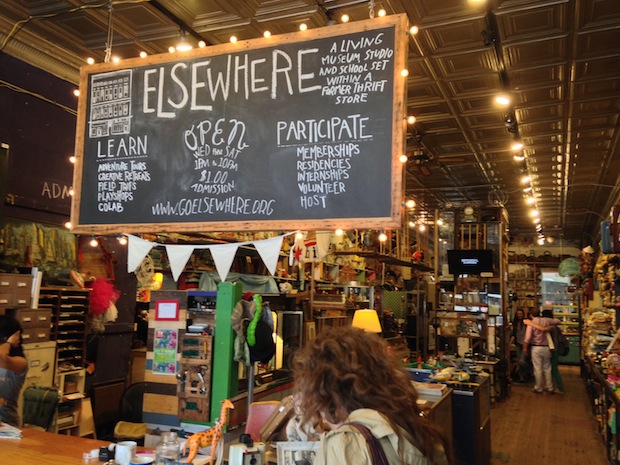
Elsewhere entrance. Photo: Whitney Kimball
Elsewhere
606 South Elm Street, Greensboro, NC
May-December
Note: The Museum is currently closed through May 2015 for renovation.
Elsewhere Tours
With his partner Stephanie Sherman, George Scheer converted his grandmother Sylvia Gray’s three-story thrift store in Greensboro, NC, into an incredible artist residency program overflowing with old toys, clothing, fabric, instruments, etc. I would visit every day if I could.
Artists residents reconfigure the items into various projects– but no object leaves the building. I imagine that tons of bad art gets made here, which is fine. My sense, while visiting was that Elsewhere is a place to shed your self-consciousness and find out how far you can stretch yourself as an artist. A few words I wrote last year on the subject:
The whole place feels like a living artwork. Pieces I’d seen and loved when I was there last year—a ladder used as a shelving unit and firetruck hat stand—were transformed into other things I loved: an Elsewhere Community Broadcast center that used a CRT TV with the screen removed as a set for constantly arranged canvases. Others pieces were more permanent: a wall-mounted musical instrument made of piano strings, drums, cymbals, et cetera, and played with bouncy balls you throw at the piece had been there since the early aughts. Another piece, a tornado of dolls, hangs off the peeling roof of a room in the upstairs, and has been there for years. It’s creepy because dolls are creepy, but also because if you look at for a while the piece starts to look like a unique form of Elsewhere mold.
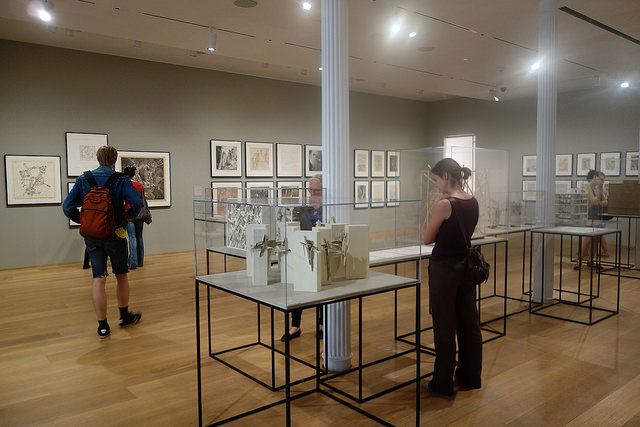
Lebbeus Woods at The Drawing Center. Photo: Paddy Johnson
The Drawing Center
35 Wooster Street, New York, NY
Soho
April 17-June 15
Lebbeus Woods, Architect
“Maybe I can show what can happen if we live by a different set of rules”, architect Lebbeus Woods (1940-2012) once said. It’s that desire that laid the groundwork for a show filled with scientifically improbably visions visions of the future. Most of the maquettes and studies in this show could never be built—it’s a sci-fi wonderland of futurist cities, a space tomb for Einstein, and constructions for harnessing energy and light—and it all seems vaguely familiar. Likely, that’s because Woods’s influence has permeated mainstream culture. For example, a drawing of chair affixed high on a wall with a round floating probe above clearly inspired scenes in the 1995 science fiction film “12 Monkeys”. This is not architecture for the happy.
Of all the work, probably the most impressive was “Sector 1576N from A-City”, a pencil drawing of a baroque futuristic fortress miniaturized by the surrounding forest. Somewhere between industry and empire, the rendering feels eerily static. Who built this structure? Who maintains it? As a viewer, you never find out the answers to these questions, which may be why it’s so hard to stop looking at it. Like so many works in this show, the drawing mesmerizes.

Jane Corrigan, Three Girls in a Field, 2014, Oil on Linen, 27 x 36.5 inches
Kerry Schuss
34 Orchard Street, New York, NY
Lower East Side
September 13-October 26
Jane Corrigan
I’m looking back on this Jane Corrigan show at Kerry Schuss this September, and I’m still floored by the skill of this painter. She’s incredible. An excerpt from what I wrote three months ago:
It’s been at least two years since I’ve seen a painting show as strong as Jane Corrigan’s at Kerry Schuss. Eight paintings of sporty teenage girls make up this show, each of which feels like the result of a quick live-figure painting pose. Not a mark on the canvas is without a descriptive purpose. The frenetic brushwork creates a self-contained, high-intensity energy consistent with that of her teenage subjects—and we’re told the paintings are equally young. Many were delivered just a few hours before the show opened.
The canvases on view—the largest being just 39 inches—are drawn from worked-up painted sketches (available for view in the back office to anyone who asks). Amongst the stronger works in the show, “Three Girls in a Field” depicts three girls fighting for control over what one assumes is a soccer ball. One girl’s face is barely rendered—it’s a mess of scribbly painting that matches the wind in her face—while her opponent’s eyes bug out, almost cartoonishly, as she grabs a hold of the girl’s arm. In another painting we see a girl on the ground with a shocked and near fearful look on her face thanks to a bloody scrape on her knee.
The mastery in these works lies not just in their technical skill, but that the subject matter feels true to life. The paintings imagine a fictional world not that far from our own. These girls could be our daughters or our young friends. Like most teenagers, though, while they may be aware of our presence, they are too wrapped up in their own activities to care.
Jen and Paul’s One Stop Souvenir City and Chelsea Bus Tours
Chelsea, New York, NY
September-December
Jennifer Catron and Paul Outlaw: Jen and Paul’s One Stop Souvenir City and Chelsea Bus Tours
I have a nine-dollar bottle of editioned Paul McCarthy ketchup from Jen and Paul’s One Stop Souvenir City and Chelsea Bus Tours; it’s one of my favorite works of art. It’s entirely useless and has a value that is artificially inflated—just like art in Chelsea.
That ketchup came from the lower level of their tour bus, which doubles as a souvenir shop. In it, you can buy editioned souvenirs of some of the most famous art shown in the most upscale Chelsea galleries. That includes a clay shark in formaldehyde inspired by Damien Hirst; a tote bag with the words “I [picture of PS1 Director Klaus Biesenbach’s head] Art”; and a dancing toy robot meant to approximate Jordan Wolfson’s lifelike stripper robot which was purchased by mega collector Eli Broad earlier this year. They’ve also made a game of art monopoly that includes a picture of my head on one of the squares—land on me, and you get a negative review that costs you a hundred bucks.
BONUS

Anila Quayyum Agha, Intersections, 2014 at ArtPrize
ArtPrize
Grand Rapids Art Museum
01 Monroe Center Street Northwest, Grand Rapids, MI
September 24 – October 12
Anila Quayyum Agha, Intersections
Growing up, we used to listen to the CBC’s “Cross Country Check-Up,” a show that asked Canadians to call in and express their opinions on practically any topic. That meant an hour-long segment of uninformed blather; thankfully, we only listened to it until my mother could no longer stand it. It usually took about five minutes or less for my mother to consider those remarks an embarrassment to the country. Populism can be ugly.
Perhaps no other exhibition reflects this more clearly than ArtPrize, a national art competition that takes place in venues across the city of Grand Rapids, MI in which its residents chose the winners of the public vote prize (along with a curator’s juried prize). The public vote winners almost always pander to the lowest common denominator, which, for a critic, can be a little heartbreaking, given the amount of foot traffic these exhibitions get. It’s incredible how many people see this work.
It’s for this reason that this year’s public and juried prize winner, Intersections by Anila Quayyum Agha, should be cause for real celebration; it does not pander, nor does it need any explanation to succeed. Inspired by the geometrical patterning in Islamic sacred spaces, this stunning lit cube of cut wood casts shadows around the entire room.
While writing this, AFC’s Whitney Kimball asked me why this isn’t just an Islamic version of the stained glass Jesus that won three years ago. This version is more tasteful and abstract. She makes a good point, but in the context of this exhibition, it’s hard to see this cube as anything other than a victory for the public. Christianity is the dominant religion in Grand Rapids, not Islam, which is currently having its reputation drawn through the mud thanks to a few extremists. While the abstract elements in this piece may allow people to forget politics, I like to think this winner at least subtly offers a broader perspective than what we’ve seen in the past. In my opinion, that’s a huge step forward.

Jeff Koons at The Whitney Museum of Art
The Whitney
945 Madison Avenue, New York, NY
Upper East Side
June 27-October 19
Jeff Koons: A Retrospective
A retrospective that gave us a clear overview of Koons’s art-making career, from his early culture-jamming work with subway poster appropriations and ceramic reproductions, to his later giant balloon sculptures and hanging hearts.
Mostly, this retrospective makes my list because it brought together so much of his early work into one space. Take, for example, Koons’s iconic Equilibrium series, which doesn’t appear to have much to say when you see only the two balls floating in a fish tank. (And typically people see this piece on its own—the sculpture is the most frequently shown of all the works in the series, and its image the most highly circulated.) Displayed in the context of shoe ads targeting African-Americans, and bronzed life boats, though, the basketballs take on a more socially-conscious role.
Koons is a master formalist, but he also had something to say. Once. The later work is mostly subpar—a giant pile of play-doh made “because kids like it” (to paraphrase the artist) is pretty vacuous, as is a giant metal balloon dog made because collectors like it. It can be hard to get over that kind of lavish excess, and while the earlier work helped me over that hump, it won’t help everyone.


Comments on this entry are closed.